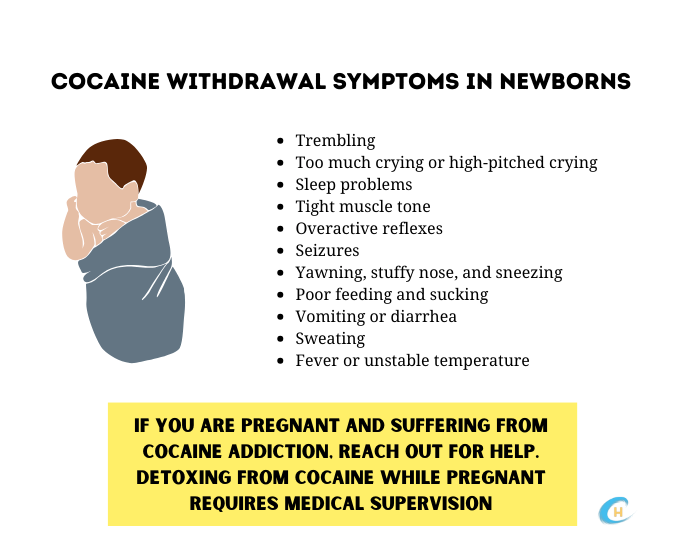Cocaine Withdrawal Symptoms in Newborn Babies
Stimulant drugs such as cocaine are powerful substances that can negatively affect users when abused. If a mother decides to use drugs while she is pregnant, she is putting her child at risk for many health problems including having neonatal abstinence syndrome (NAS). Almost every drug or medication taken by the mother can be passed from the mother’s bloodstream through the placenta to the unborn baby. Cocaine use during pregnancy can cause NAS and cocaine withdrawal symptoms in newborn babies.

Neonatal abstinence syndrome is a condition in which babies who are exposed to a narcotic drug in the womb before birth, can experience withdrawal after birth. This happens when the mother is addicted to substances during her pregnancy. The withdrawal symptoms can begin shortly after birth and can last for several weeks after. Some drugs are more likely to cause NAS compared to others. The most common drugs that cause this condition are opioids, stimulants, antidepressants, sedatives and nicotine.
Despite opioids such as heroin and methadone causing over half of NAS withdrawal symptoms in babies exposed to narcotics in the womb, withdrawal symptoms can also occur in babies who have been exposed to cocaine during pregnancy. Cocaine can cross from the mother’s bloodstream through the placenta. In fact, it can take longer for a newborn baby to get cocaine out of their system.
Neonatal Abstinence Syndrome
Neonatal abstinence syndrome can cause serious health effects for newborn babies. Symptoms of this condition can also vary and depend on the type of drug the baby was exposed to, the last time in which the baby was exposed to the drug and if the baby was born at full term or prematurely. This is because babies born prematurely have had less exposure to the drugs compared to babies born at full term, who have had more exposure to addictive substances. Premature babies also have a lower risk of developing withdrawal symptoms, have a less severe case or can recover faster because of the less exposure time.
Symptoms of withdrawal can begin as soon as 48-72 hours after birth. It can also begin as late as 5-10 days after birth. On average, most symptoms last for about 7 days. In more severe cases, symptoms can rage on for as long as an agonizing 6 months.
NAS can be determined by a standardized system that allocates points for each NAS symptom. A meconium test can also be performed. This is a test that evaluates the baby’s first bowel movement. And a urinalysis assessment is another test in which the baby’s urine is examined.
Babies who experience these drug withdrawal symptoms are irritable, in pain and often have a difficult time being comforted. It causes an unusual increase in body activity and the baby will need to be fed extra calories and given an IV of fluids to help with the side effects of vomiting and diarrhea. In severe cases, medication may need to be prescribed to help relieve the discomfort they are experiencing.

Symptoms of NAS
- Fever
- Blotchy skin – excoriation is described as skin irritation on the chin, knees, cheeks and elbows
- Sweating – signs of sweating on the forehead, upper lip or back of the neck that is not due to swaddling
- Nasal flaring, muscle stiffness and sneezing
- Difficulty breathing
- Dehydration
- Slow weight gain
- Trembling and shaking – mild, moderate to severe tremors of arms and legs when and without being held
- Excessive crying and high-pitched crying
- Difficulty sleeping
- Overactive reflexes
- Excessive yawning – yawning more than 3 times within an assessed interval
- Vomiting and diarrhea
- Seizures
- Poor feeding – infrequent sucking during feeding or gulping and stopping frequently to breathe
- Excessive sucking – the act of sucking three times per interval while swiping hands across the face in an attempt to suck on hands or fingers
- Myoclonic jerks – the twitching of muscles of the face or other extremities
- Increased muscle tone – total body rigidity and tightness in arms and legs
Check Your Insurance Coverage for FREE
Find out if your insurance covers addiction treatment in minutes. We accept most insurance!
Cocaine Withdrawal Symptoms in Newborns
Cocaine exposure to unborn babies can cause a whole host of health problems including withdrawal symptoms. However, the most dangerous of symptoms is the toxic effects of cocaine itself. Cocaine works by preventing catecholamine reuptake at the presynaptic nerve endings. Catecholamine is a type of neurotransmitter that affects motor control, cognition, memory processing and the endocrine system. This increases the amount of the neurotransmitter in the body and can cause an increase in blood pressure and elevated heart rate.
- Poor intrauterine growth
- Premature or preterm birth – A birth that happens too early in the pregnancy before 37 weeks.
- Seizures
- Birth defects
- Sudden Infant Death Syndrome (SIDS) – Babies exposed to cocaine in the womb are at high risk for SIDS. The risk for SIDS is 8.5/1000 in cocaine-exposed infants, which is twice as high for infants who have not been exposed to cocaine.
- Placental Abruption – A serious condition in which the placenta separates from the wall of the uterus before birth. The placenta provides the baby with food and oxygen through the umbilical cord and when a placental abruption happens, it can cause heavy bleeding and potentially become deadly for both baby and mother.
- Low birth weight – A baby is considered low birth weight when they are less than 5 pounds 8 ounces.
- Risks for miscarriage – Miscarriage occurs when a baby dies in the womb before 20 weeks of pregnancy.
Cocaine exposure to babies in the womb can cause long-term health problems, which include behavior issues, learning difficulties, difficulty paying attention, and vision and hearing problems. Delays in language development are also common. Some newborns will face late development of motor skills and a risk for microcephaly. Microcephaly is an abnormality in brain growth. It is an impairment of the brain and affects brain size ultimately leading to reduced head size. This is a major predictor for depressed cognitive functions, which affects the baby’s central nervous system.
Another symptom of fetal exposure to cocaine is fetal distress and meconium staining. This occurs most commonly in cocaine-exposed babies. Newborns can also display symptoms that mimic sepsis such as extreme lethargy, weak muscle tone and decreased responsiveness to external stimuli. Like with NAS, cocaine-exposed babies can also develop an intense sucking reflex when the infant gets older.
Reach out to Hotel California by the Sea
We specialize in treating addiction and other co-occurring disorders, such as PTSD. Our Admissions specialists are available to walk you through the best options for treating your addiction.
Treatment for Cocaine Addiction
Cocaine is a highly potent and dangerous stimulant drug. It can be especially dangerous when being used while pregnant because it will expose unborn babies to the drugs causing uncomfortable and painful withdrawal symptoms in newborns. Overcoming an addiction to cocaine is difficult, but like any other mental health disorder, it is possible through effective care and support. Treatment programs such as Hotel California by the Sea provide high-quality care, treatments and resources patients need in order to recover from their drug addiction.
We specialize in treating substance use disorders such as cocaine use disorder. We offer medical detox, inpatient residential treatment and outpatient treatment programs. In addition to offering varying levels of care, we utilize the most effective treatment methods including CBT, DBT and group therapy. Our facilities are staffed with clinicians, therapists, counselors, psychiatrists, case managers and other rehab-supportive personnel. Hotel California by the Sea is dedicated to helping clients in all levels of addiction and recovery to achieve a life of health and sobriety.
References:
https://www.stanfordchildrens.org/en/topic/default?id=neonatal-abstinence-syndrome-90-P02387
https://www.childrenshospital.org/conditions/neonatal-abstinence-syndrome-nas
https://www.addictioncenter.com/addiction/neonatal-abstinence-syndrome
https://www.marchofdimes.org/find-support/topics/pregnancy/cocaine-and-pregnancy
https://www.ncbi.nlm.nih.gov/pmc/articles/PMC4327946
https://www.contemporarypediatrics.com/view/prenatal-cocaine-whats-known-about-outcomes
